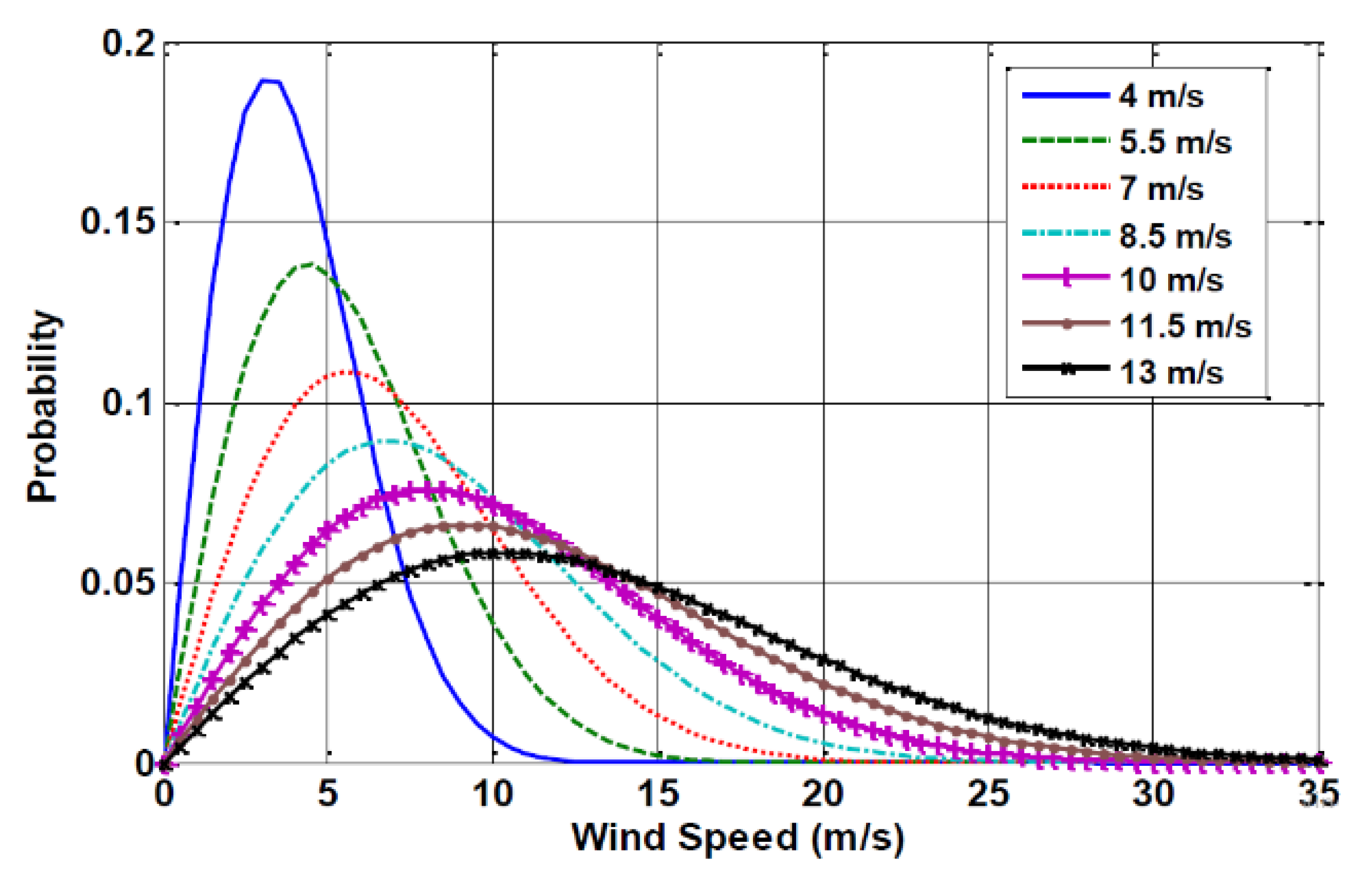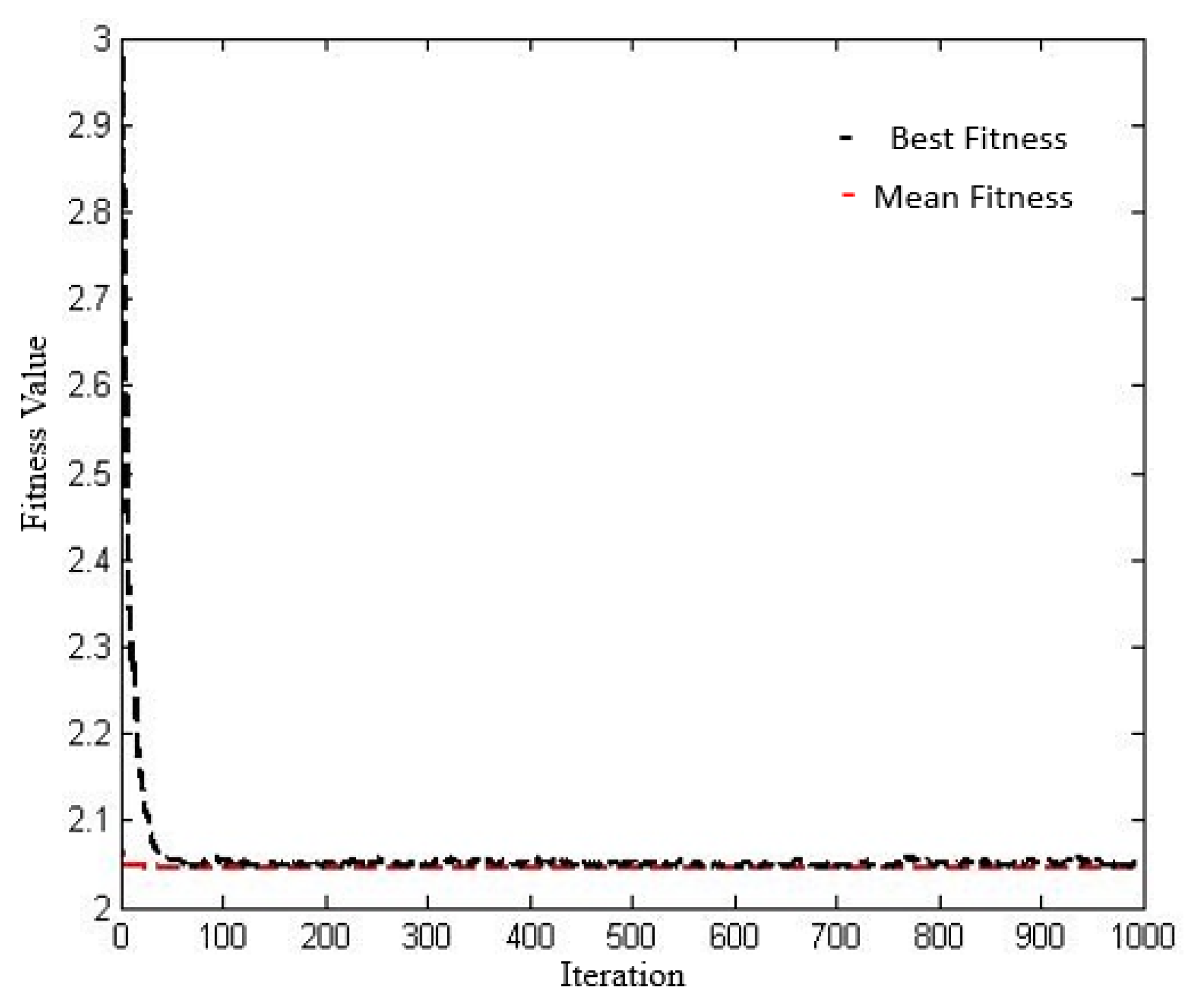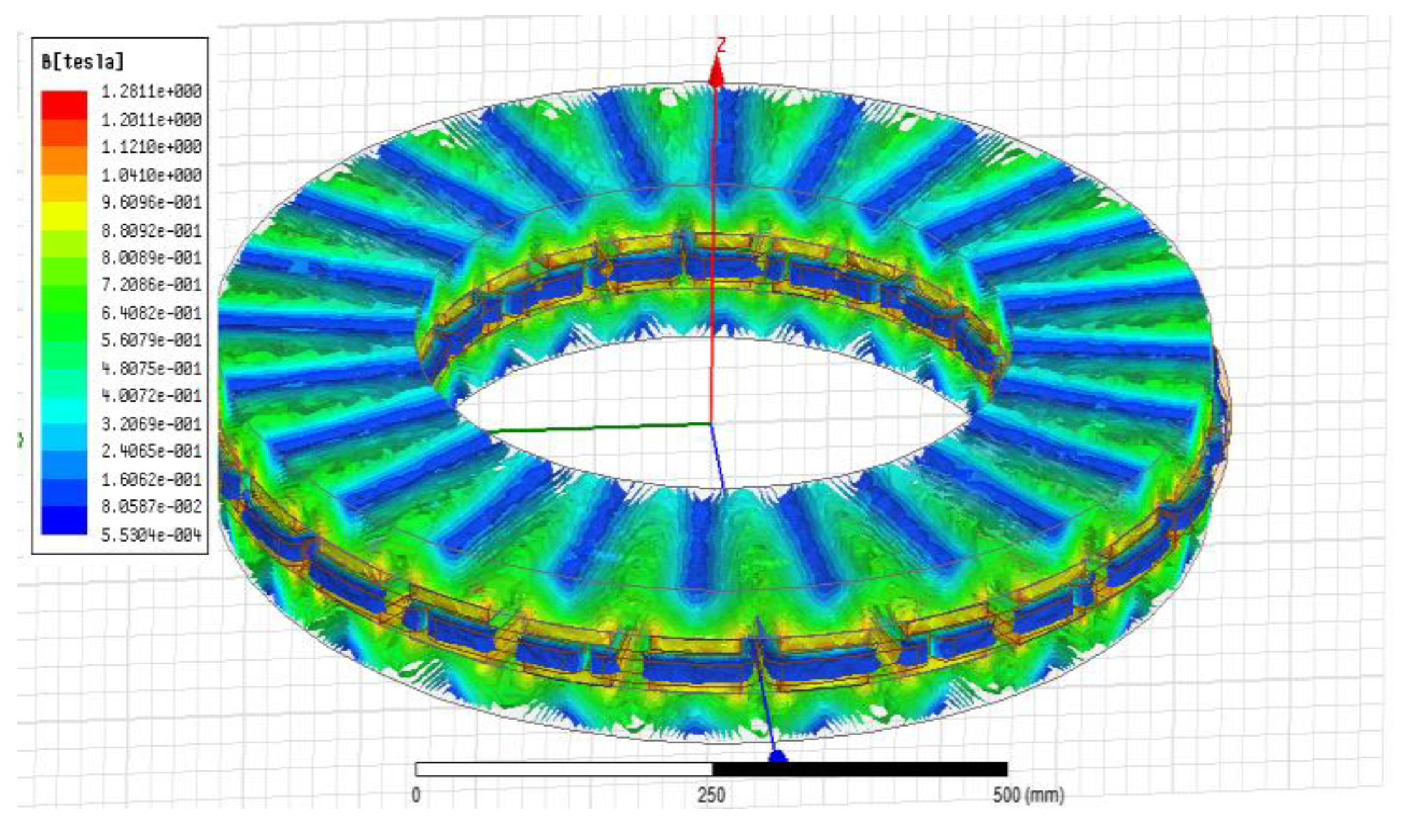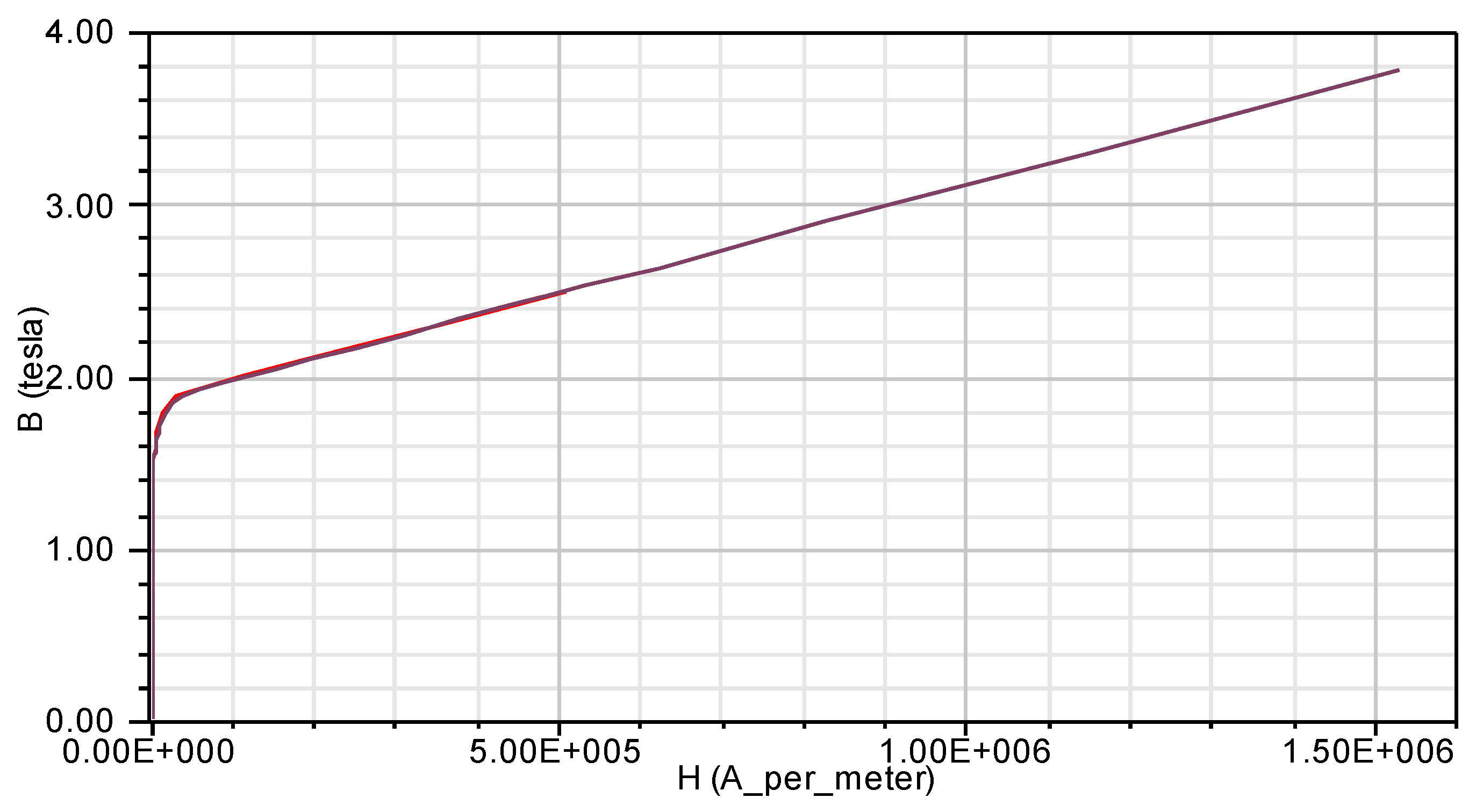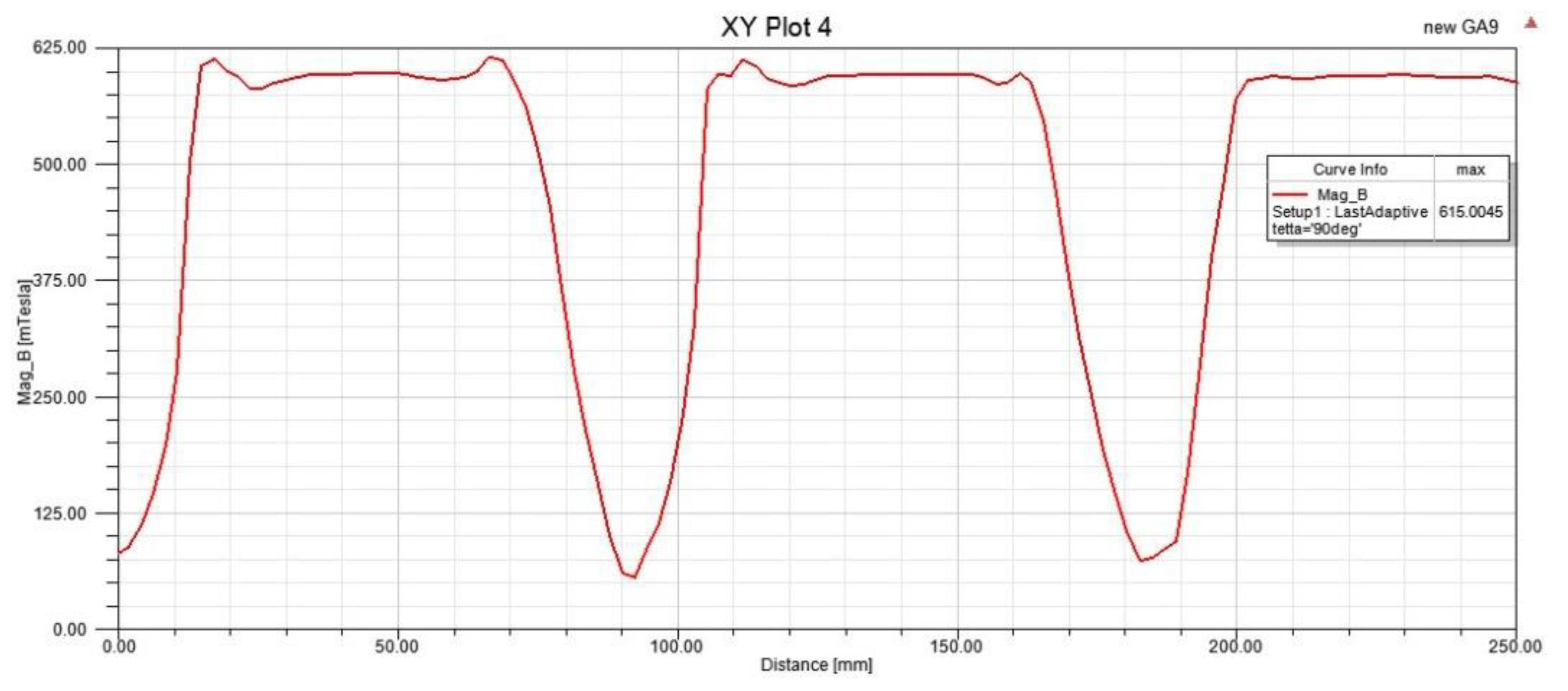1. Introduction
By the end 2018, global renewable power generation reached 2351 GW, of which 24% (564 GW) was attributed to wind power [
1]. Although a global target for wind power to be 50% of all renewable power has been set for 2030 [
2], current projections suggest the proportion is more likely to be between 20% and 25% (1300 GW) [
3,
4]. Therefore, significant changes are required in wind energy policies and the related technologies and apparatus in order to meet the intended target.
Wind turbines are generally divided into two types of those with and without gearboxes. The main disadvantages of gearbox are high maintenance costs, high weight, and noise generation [
5]. Additionally, in the gearbox-based turbines, system losses are high and thereupon the efficiency is low compared to the gearbox-less type. In wind energy systems, using a low-speed generator is a way to remove the gearbox and so the rotor speed would be equal to the rotational speed of the turbine. A detailed comparison between these types of wind energy conversion systems has been provided in reference [
5]. This analysis has led to the conclusion that the direct-drive permanent-magnet generator could be the best solution. Due to the elimination of the brushes and gearbox, it has the advantages of a fully rated converter.
The minimum required speed in gearless turbines is a serious constraint and is often subjected to designing a specific type of generator for this application. Permanent magnet generators provide the required frequency at low speeds by increasing the number of poles. The magnetic fluxes generated by these poles can be in the radial or axial direction of the machine. So, the types of permanent magnet generators are then categorized as axial flux and radial flux [
6].
Due to the axial movement of the air gap flux, these are of the disc-shaped machines [
7]. This structure, because of the higher ratio of the diameter of the machine to its length, exhibits characteristics such as high torque density and high efficiency, as well as is suitable for design with a high number of poles. These advantages make the axial flux permanent magnet synchronous generator the best option for coupling with gearless wind turbines [
8].
Permanent-magnet machines are diverse in terms of rotor and stator construction. These machines can be in the form of a single- or double-side rotor, slot-less and coreless stator, or with a slotted stator and core. Furthermore, the permanent magnet can be buried in or attached to the surface of the rotor disk [
9].
Double-sided permanent-magnet machines are often preferable due to the balance of the force between of the discs. This topology consists of a stator placed between two rotor discs [
10]. The main advantages of coreless stator machines are the lack of cogging torque, low weight, high efficiency, and simple structure. However, concern has been reported about the harmonics from a grid perspective. The absorbent force between the rotor and stator discs, which has contributed to the structural strength of the machine, can also be neglected with a coreless stator [
11].
A comparison of the ferrite magnet performance in the axial flux machine and radial flux-type reported in references [
12,
13] provides a comprehensive overview of the application of different magnets in these machines. The results show that the low-cost ferrite magnet has much lower energy than the NdFeB magnet and is not advisable.
In reference [
14], the spoke-type permanent-magnet Vernier machine has been used for direct-drive applications. This type of design reduces the ratio of pole width to pole pitch, which results in the decline of the machine power. So, increasing the number of machine poles is mandatory. Due to the arrangement type of the poles, only the structure of a single rotor and dual stators on both sides of the rotor can be used for this application. Therefore, the copper losses in these types of machines are much higher than their rivals.
The development and improvement of the design approach as well as the optimization of the related equations are paramount to achieving the best topology. In this regard, it is proposed in reference [
15] to develop and improve the design of an axial flux permanent magnet synchronous generator using a genetic algorithm. The objective of this study is to minimize the production cost and its indicator is the total price of the magnet. Based on the finding of this research, the utilization of a core in the stator has resulted in the generation of cogging torque in this machine. To reduce the effect of cogging torque, a permanent-magnet-shift mechanical technique has been used in [
16]. Cogging torque is an inherent feature of permanent-magnet machines, which results in rising inertia and an inappropriate start-up speed. The acceptable value for cogging torque is 1–2% of total generator torque. In this study, the weight of magnetic materials has increased dramatically, which is not economic.
In reference [
11], the optimal ratio between the number coils and poles, minimizing the effective weight of the permanent magnet and maximizing the annual energy production of the slot-less axial flux generator has been investigated. Due to the lack of an integrated method in this study, some important quantities such as coil weight have been non-optimally obtained. The optimization of a slotted motor which is driven by a spiral-type stator using a Genetic Algorithm and the related comprehensive dimensional equations are presented in reference [
17]. The principal aims of this research are maximizing the sinusoidal voltage and power density, as well as reducing cogging torque. The analysis of a permanent magnet flux machine with a coreless stator is presented by reference [
18]. The article makes a comparison between the performance of two types of non-overlapping concentrated stator windings.
In the analysis and the design of AFPM machines, a set of parameters including the air gap flux density, cogging torque, effective weight of consumables, eddy current losses, efficiency, and magnetic-field leakage flux have been conventionally considered by the researchers [
19]. In the design of electric machines, there are other optional variables that the designer determines according to the objectives of the design or based on the experience. These variables affect the performance characteristics and the dimensions of the machine. The GA featuring a population of parallel points to be searched as opposed to a single-point search of the nonlinear nature of optimization makes GA the most suited technique for this application [
20].
The magnetic field of an electric machine can be determined analytically or numerically via the Finite-Element Method (FEM). FEM is more accurate than the analytical method and can be used in the machines with complex structures and a special magnetic circuit rather than the conventional Radial Flux Permanent Magnet (RFPM) Machines [
21,
22].
In the design of the AFPM machines, with due attention to the high cost of permanent magnet materials, limitations in the dimensions and size of the machine, the necessity of power generation at low speeds, coherence and the strength of the machine structure, a reduction of the machine losses including cogging torque, copper and hysteresis losses, high efficiency, and high-power density, it is absolutely essential to have an integrated design approach. This important process can be achieved using the elitist genetic algorithm optimization technique, as well as being validated by the finite element simulation.
The review of the literature, considering the advantages and disadvantages of various types of AFPM machines from a technical perspective and consistent with the wind speed of the geographical area of operation, has led to finding the best topology for this application. In the course of this research, two rotors joined with a single-core slot-less stator structure was selected as the best suit. When this structure uses in an optimal design, it is capable of reducing copper loss, increasing power density, mitigating cogging torque, and reducing the total weight.
The earlier evaluations have illustrated that the Genetic Algorithm is the most powerful metaheuristic optimization approach when finding the global optima is the main concern and there is no restricted time limitation [
23]. Therefore, genetic optimization algorithms have been used to design this machine when maximizing the efficiency and induction voltage, as well as when minimizing the weight of the permanent magnet. Afterward, finite element analysis has been used to evaluate the robustness of the proposed approach.
3. Main Design Equations
The main parameters of an ironless Axial Flux Permanent Synchronous Generator (AFPMSG), such as diameter, can be expressed using the output power equation by ignoring the leakage flux of the machine [
9,
27]. The output power is given by the Equation (6):
where
η is the efficiency of the machine,
Epk and
Ipk are the maximum voltage and the peak of the phase current of the Electric Movement Force (EMF), respectively.
m is the number of machine phases, and
Kp is the power waveform coefficient which is visually presented in
Table 2 and can be found by the following equation:
where
T is the period of one cycle (EMF),
e(
t) is the induction voltage caused by the flux density of the air gap, and
i(
t) is phase current. Assuming the sinusoidal density of the air gap flux, the maximum induced phase voltage of the AFPM machine is shown in Equation (8):
where
is the number of winding turns per phase,
is the air gap flux density,
Dout is the outer diameter of the machine,
ns is the synchronous speed, and
is the ratio of the inner diameter to the outer diameter of the machine.
Related to Equation (6), the maximum phase current is given by Equation (9):
where
m is the number of phases and
A is the specific electric loading of the machine.
The specific electric loading of a machine is the circumferential current density of the stator. The range of specific electric loading values (
A) for small PM machines is typically 10,000–40,000 A/m [
28,
29]. In the general case, the total electrical loading A should include both the stator electrical loading
As and rotor electrical loading
Ar, so that:
where
Kϕ =
Ar/
As is the ratio of electrical loading on the rotor and stator. In a machine topology without a rotor winding
Kϕ = 0 [
27].
Therefore, combining Equations (6) and (9) yields the main and final equation of the output power of an AFPM machine, which is found in Equation (11):
In this equation,
ns,
kw,
αp and
are the synchronous speed, the coil coefficient, the arc pole-to-pitch pole ratio, and the machine power factor, respectively,
is the air gap flux density,
η is the efficiency of the machine, and
is the ratio of the inner diameter to the outer diameter of the machine. In addition, the power density of the machine, which is the ratio of the output power of the machine to its total volume, is formulated as Equation (12) [
6,
23]:
Lt represents the axial length of the machine and is composed of four parts, as illustrated by Equation (13):
where,
Lcr is the thickness of the rotor disk,
g is the air gap,
tw is the thickness of the coil, and the thickness of the permanent magnet is abbreviated to
Lpm. In the design of machines with a large number of poles, the rotor disk thickness should be considered as a mechanical constraint [
7]. In a similar manner, the upper limit of the rotor flux density must be considered as another design constraint.
Considering the magnetic saturation of the rotor back iron disc is required to determine the axial length of the rotor, in this paper, the axial length of the rotor disk is computed based on the inducement of the maximum unsaturated flux which protects the machine from an increase of the core (magnetic and heat-related) losses. Regarding this condition, the axial thickness of the rotor back iron disk might be formulated as follows [
7]:
In this equation,
Bu is the average of the surface flux density of a permanent magnet, which is 1.25 Tesla for the
NdFeB magnet [
8]. Moreover,
P is the number of poles,
λ is the AFPM diameter ratio
(Di/Do), and
Bcr is the maximum permissible flux density for the rotor core, which is determined for soft steel alloys at frequencies above 40 Hz by the following Equation [
27]:
The core of rotor disc in the proposed design is made from M19-29G steel, which is a ferromagnetic material with nonlinear behavior. Therefore, the maximum unsaturated flux density for this material is less than 1.85 Tesla [
5,
24].
Lpm is the axial thickness of the permanent magnet, which is a highly effective quantity in the design of permanent magnet machines. This parameter depends on the air gap and thickness of the coil, as given in Equation (16) [
8,
10]:
where
is the magnet’s recoil relative permeability. Furthermore, the thickness of the coil can be found from Equation (17) [
6]:
where
tw is the coil thickness,
g is the air gap,
Br is the permanent magnet residual flux density,
Bg is the air gap flux density,
μr is the relative recoil of the permanent magnet, and
Kpm is the leakage flux factor which defines
Bgpk/
Bg as the peak-value correction factor over the air gap flux density in the AFPM machine’s radial direction. Equations (16) and (17) illustrate that the axial thickness of the permanent magnet (
Lpm) and the coil thickness (
tw) are interconnected parameters. Therefore, the optimal values of these parameters should be determined according to the relationship between them.
Using an NS structure for the arrangement of the magnets, the opposite poles (N, S) are facing each other. The creation of this condition in the generator permits the maximum flux linkage through the magnetic path of the machine. Later, this issue is confirmed by the results of finite element simulation. Another result of selecting the NS structure for the placement of the magnets in the under-design machine is that the leakage flux factor declines considerably.
Figure 2 shows the structure of the machine components separately.
Most of the research on the design of the AFPM has not addressed inductance calculations. While the accuracy of the magnetic design of the generator in the next step confirms its validity, it depends on the accurate calculation of the inductance. It is evident that the synchronous inductance consists of two parts: the armature reaction inductance and the leakage inductance. For an air core (iron-less) stator, the magnetic saturation of the rotor disks with surface-mounted magnets is negligible. The inductance of the axes
d and
q are equal in the machines with magnetic symmetry. So, the armature reaction inductances for the two axes
d and
q are given by [
9,
30]:
where
Rout and
Rin are the outer and inner radii of the machine, respectively, and
Nph is the number of winding turns per phase.
g’ expresses the equivalent air gap at the axes
d and
q for the surface-mounted magnet structure which is redefined as [
9]:
where
Lpm is the axial thickness of the permanent magnet and
is the reversible magnetic permeability. The leakage inductance is also represented by the summation of three components: the slot leakage flux inductance, the leakage flux inductance in the end winding, and the differential leakage inductance, which is expressed as follows:
where
is the active length of a coil that is equal to the radial length of the PM,
q is the number of coil arms per pole per phase (equivalent to the number of slots),
Le is the average length of the single-sided end connection,
L1s and
λ1s are the inductance and Specific permeability for leakage flux around the radial areas of conductors,
L1e and
λ1e are the inductance and specific permeance for the leakage flux about radial portions of conductors (corresponding to slot leakage in classical machines), respectively,
L1d and
λ1d are the inductance and specific permeance for the leakage flux about the end connections, respectively, and
L1d and
λ1d are the inductance and specific permeance for the differential leakage flux (due to higher space harmonics), respectively. It is difficult to derive an accurate analytical expression of
λ1e for a coreless electrical machine. The air gap’s specific permeances
and
can roughly be estimated from the following semi-analytical Equation [
9]:
In an AFPM iron-less machine, the major losses are copper and eddy current losses. For a coreless AFPM machine, a copper loss is calculated from the following equation:
where
R and
Ia are the resistance and phase current of the stator, respectively, and
m is the number of phases.
In an AFPM machine with a coreless stator, the winding is directly exposed to the air gap’s magnetic field. The motion of permanent magnets in the vicinity of the coreless winding produces an alternating field through each conductor and an eddy current is induced. The loss due to eddy currents in the conductors depends on both the geometry of the wire cross section and the amplitude and waveform of the flux density. Regardless of the tangential component of the field, the eddy current losses in the stator winding can be calculated for round conductors as follows [
9,
11]:
where
dw is the conductor diameter,
σ is the electric conductivity,
is the conductor-specific mass density,
Mcu is the mass of the stator conductors without insulation and end connections (effective coil mass),
fis the stator current frequency,
Bz is the axial components of the magnetic flux density, and
is the distortion coefficient which is 1 for the eddy current under a sinusoidal flux density.
The effective weight of the coil, which is directly exposed to the rotor magnetic field, plays an important role in the determination of the eddy current losses. So, the mass of the stator radial conductors can be given as follows:
where
aw is the number of parallel paths of the coil.
Finite element simulations show that the mechanical losses, such as friction in the bearings and windage losses, can be neglected in the design of the AFPM machine. So, the efficiency of the machine reduces to:
where
Pout is the output power,
Pcu is the copper loss, and
Peddy is the eddy current loss of the machine.
6. Finite Element Analysis and Results
Finite Element Method (FEM) analysis is performed to evaluate the validity of the optimal design procedure presented in previous sections. Three-dimensional finite element analysis is used to analyze the sinusoidal induction voltage and flux density throughout the machine, and precisely determine the inductance value of the coils. A 3-D FEM of the ironless AFPMWG is simulated using ANSYS Maxwell 16.0.2 (ANSYS, Inc., Canonsburg, PA, USA). The EGA-optimized parameters shown in
Table 5 are the basis of the finite element simulation model.
The accurate calculation of the rotor disk thickness is performed by the proposed design approach. Finite element analysis confirms there is not a magnetic saturation phenomenon, nor the related critical thermal losses. In the static magnet analyses, the 3D-FEM model of the designed wind generator has been developed and a sample of the results is visually presented in
Figure 5.
Given the figure, it is clear that the maximum magnetic flux density in the rotor discs is slightly lower than the knee point and the saturation level. Achieving the optimum rotor disc thickness results in the absorption of the maximum flux density, while magnetic saturation does not occur in the rotor discs. The alloy considered as the constituent of the rotor disc is the M19-29G, with a nonlinear behavior whose B–H curve is shown in
Figure 6.
The characteristic curve of this alloy indicates that the knee point occurs at 1.85 Tesla. In fact, the maximum absorption capacity of the magnetic flux density before reaching the non-linear part of the curve (saturation) is 1.85 Tesla. Due to the magnetic flux density distribution in the rotor discs, as shown in
Figure 5, the disc thickness is designed to provide the maximum permissible flux density, optimizing the weight of the discs, reducing the total effective weight and the inertia of the machine, as well as making the start of the machine easier.
Figure 7 shows the distribution of the air gap flux density over the mean radius of the machine, which is the cogging torque, and the ripple flux percentage is zero. The air gap flux density value measured in the finite element equals 0.625 Tesla.
The analysis of various synchronous generators illustrated that in the permanent magnet type, due to the absence of the excitation coil in its rotor, the generator power factor cannot be adjusted by the excitation current and the related rotor winding equal reactance is ignored. Therefore, the power factor is affected by the connected load of the generator. In most studies, the power factor of permanent magnet machines is considered to be close to 1 under the Resistive-Inductive (RL) load.
The 3-phase induction voltage of the generator is shown under the RL load with a power factor = 0.95 in
Figure 8. It is evident by the results that the generator has a sinusoidal output voltage.
The results of the 3D FEM transient analysis are given in
Table 6 and compared with the fundamental component of the analytical results. The results confirm there is a high consistency between the FEM and analytical results.
In addition to comparing the analytical and finite element results in
Table 6, a comparison of the results of the coil inductance and its leakage inductance is also performed in the finite element magnet analysis.
The ironless machine’s inductance in the analytical model cannot be calculated due to the insignificance of the PM leakage flux. It is evident that the exact amount of inductance can be calculated by finite element analysis. Given the difference between the inductance values, which are determined using the analytical and the finite element methods, the inductance value of the PM leakage fluxes is approximately 2 mH. Therefore, the flux linkage coefficient of
Kpm = 0.93 is achieved. This small amount of flux leakage coefficient is not only acceptable but excellent for an ironless machine. The linkage phenomena and leakage flux lines for the two pairs of poles and two coils of stator can be seen in
Figure 9. It is clear that most of the flux lines are mutual and cross the desired magnetic path.
